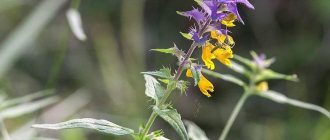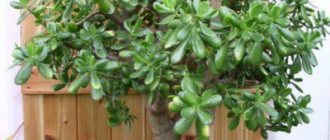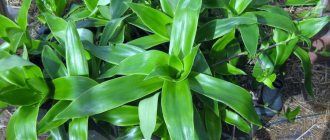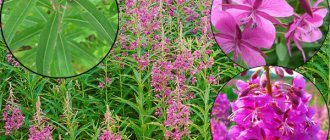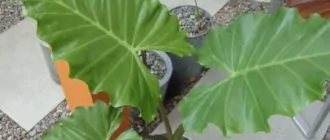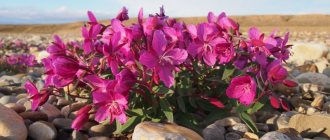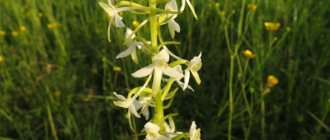Flower Ivan da Marya indoor begonia what it looks like
Begonia Ivan da Marya grows as a bush, with beautiful green leaves and red flowers. On one plant there are two types of flowers, which always appear in pairs - double ones similar to a rose and ordinary ones with four or five petals. With proper care, it blooms almost constantly, so it can decorate any interior.
Planting and care, growing rules
It is known that any variety of begonia prefers light, loose, organically enriched soil compositions. A composition of greenhouse soil, manure, and peat, taken in equal parts, is best suited. A little river sand is added to improve drainage. Begonias need good lighting. For this reason, containers with flowers are placed on windows facing east or west.
During the growing season, the plant is kept at a moderate temperature, from eighteen to twenty degrees Celsius. In winter it is lowered somewhat - to fifteen. The humidity content in the air does not matter. Additional spraying is allowed for varieties with smooth foliage. But there is a peculiarity here - water should not get on the inflorescences.
Watering with soft water is carried out regularly; the soil should not dry out. In summer its intensity is twice a week. During the hot period, the procedure is carried out daily. Make sure that moisture does not stagnate. From mid-autumn, the amount of watering is slightly reduced.
With the onset of spring, the dosage of added moisture gradually increases in order to reach the required level in May. Overmoistening of the soil threatens rotting of the root system and young shoots, and the development of powdery mildew, which can destroy the plant.
Only feed the begonia that grows in the old soil composition. Procedures are carried out weekly from May to October so that the foliage of the plant develops better. For this purpose, special preparations intended for flowering plants are used.
Transplantation and propagation features of begonia
The recommended period for replanting is early spring. It is performed if necessary, when the root system fills the entire flower container. You should not resort to such measures more often - begonia will not please you with its flowering. The fragility of the root system requires great care when replanting the plant. A drainage layer must be placed at the bottom of the pot.
The plant is propagated by stem or leaf cuttings. Tuberous varieties can also reproduce by dividing the nodules. For cuttings in the spring, prepared shoots are placed in the soil and given the opportunity to form roots, periodically moistening the soil. The method is not entirely convenient, since the sprouts often rot or form roots slowly. You can place and add an activated carbon tablet or a rooting accelerator to the water.
For leaf cuttings, the most developed leaves are determined, cut off, placed in a moist substrate (sand - 3, peat - 1 part) and placed in a shaded place.
Protecting plants from diseases and pests
Begonia is affected by downy mildew.
Excess moisture causes the formation of fungal diseases. In order to promptly detect an unpleasant problem, we recommend observing the appearance of the core of the bush and its lower leaves, on which rot or dew most often appears. Affected leaves are immediately removed, and the amount of watering is sharply reduced. These measures will prevent the proliferation of fungal pests. Begonia is most often attacked by aphids and red spider mites. They must be combated by spraying, for which special preparations are used.
Begonia is considered a wonderful plant. With proper care, it perfectly decorates a window, balcony or loggia. Doesn't require any special attention.
Excerpt characterizing Ivan da Marya
Davout was Arakcheev of the Emperor Napoleon - Arakcheev is not a coward, but just as serviceable, cruel and unable to express his devotion except by cruelty.
The mechanism of the state organism needs these people, just as wolves are needed in the body of nature, and they always exist, always appear and stick around, no matter how incongruous their presence and proximity to the head of government seems. Only this necessity can explain how the cruel, uneducated, uncourtly Arakcheev, who personally tore out the mustaches of the grenadiers and could not withstand danger due to his weak nerves, could maintain such strength despite the knightly noble and gentle character of Alexander. Balashev found Marshal Davout in the barn of a peasant's hut, sitting on a barrel and busy with writing (he was checking accounts). The adjutant stood next to him. It was possible to find a better place, but Marshal Davout was one of those people who deliberately put themselves in the gloomiest conditions of life in order to have the right to be gloomy. For the same reason, they are always hastily and persistently busy. “Where is there to think about the happy side of human life, when, you see, I’m sitting on a barrel in a dirty barn and working,” said the expression on his face. The main pleasure and need of these people is to, having encountered the revival of life, throw gloomy, stubborn activity into the eyes of this revival. Davout gave himself this pleasure when Balashev was brought in to him. He went even deeper into his work when the Russian general entered, and, looking through his glasses at Balashev’s animated face, impressed by the wonderful morning and the conversation with Murat, he did not get up, did not even move, but frowned even more and grinned viciously. Noticing the unpleasant impression this technique produced on Balashev’s face, Davout raised his head and coldly asked what he needed. Assuming that such a reception could be given to him only because Davout does not know that he is the adjutant general of Emperor Alexander and even his representative before Napoleon, Balashev hastened to announce his rank and appointment. Contrary to his expectations, Davout, after listening to Balashev, became even more severe and rude. - Where is your package? - he said. – Donnez le moi, ije l'enverrai a l'Empereur. [Give it to me, I will send it to the emperor.] Balashev said that he had orders to personally deliver the package to the emperor himself. “The orders of your emperor are carried out in your army, but here,” said Davout, “you must do what you are told.” And as if in order to make the Russian general even more aware of his dependence on brute force, Davout sent the adjutant for the duty officer. Balashev took out the package containing the sovereign’s letter and placed it on the table (a table consisting of a door with torn hinges sticking out, placed on two barrels). Davout took the envelope and read the inscription. “You have absolutely the right to show or not show me respect,” said Balashev. “But let me note that I have the honor to bear the rank of His Majesty’s Adjutant General...” Davout looked at him silently, and some excitement and embarrassment expressed on Balashev’s face apparently gave him pleasure. “You will be given your due,” he said and, putting the envelope in his pocket, he left the barn. A minute later, the Marshal's adjutant, Mr. de Castres, entered and led Balashev into the room prepared for him. Balashev dined that day with the marshal in the same barn, on the same board on barrels. The next day, Davout left early in the morning and, inviting Balashev to his place, impressively told him that he asked him to stay here, move along with his luggage if they had orders to do so, and not talk to anyone except Mister de Castro. Source - ""
Categories:
- Plants in alphabetical order
- Paraphyletic groups
- Flowering
- Twin myths
- Slavic mythology
- Ivan Kupala
- Plants in mythology
Hidden categories:
- Articles with links to missing files
- Wikipedia: No page since May 2015
- Wikipedia: Articles with links to a book without specifying the page for more than 14 days
- Articles requiring clarification of sources
- Wikipedia: Articles with value overrides from Wikidata
- Articles with links to Wiktionary
Ivan da Marya - flower legend and healer
Ivan da Marya is the name given to several types of plants. Most often it refers to oak grass, which also has other names:
- bicolor,
- Ivanets,
- brother and sister,
- honeydew,
- linden,
- scrofulous grass,
- jaundice,
- Ivanova or marks grass.
Male and female names were popularly given to plants that bloom in multi-colored or differently shaped pairs of inflorescences. These include meadow sage, periwinkle, Geneva violet, tricolor violet, and campanula.
Ivan da Marya
The colorful name of the flower was given for the contrasting combination of the yellow corolla of the flower with a purple bract. This unusual phenomenon is associated with the legend of the tragic love of a young man and a beauty. Ivan is associated with the color yellow, and Marya with purple. The ancestors endowed the flower with magical properties and kept it in the house as a talisman of marital happiness and protection from evil forces.
Ivan da Marya is part of the wreath for fortune telling on Ivan Kupala. The union of yellow and blue is considered a combination of the elements of water and fire. According to legends, the flower helps to establish a union between man and the gods, heavenly and earthly. The flower gives eternal happiness, harmonizing the elements of yin and yang.
The grass collected on Kupala night was tied into brooms and taken to the bathhouse to gain health and well-being.
IVAN-DA-MARYA
DESCRIPTION, USEFUL PROPERTIES, APPLICATION AND RECIPES OF PRODUCTS FROM IVAN-DA-MARYA
DESCRIPTION OF IVAN-DA-MARYA Ivan-da-Marya is known as a herbaceous plant, which is often called tricolor violet . It is also known as pansy, brother, earthflower, ball, magpie's eye and triflower. The plant is widespread in the forest zone of the European part. It often grows among bushes, in open spaces, in meadows and as a weed in fields and vegetable gardens. Prefers fertile soils, but is also found on dry, gravelly soils on mountain slopes.
IVAN-DA-MARYA - COLLECTION AND PREPARATION As a medicinal plant, tricolor violet was known in ancient times. Currently, it is well studied and used in medicine. The grass is harvested as a medicinal raw material during the flowering period. It is cut at a short distance from the ground and dried in the shade in the open air. The grass contains saponins, flavone glycosides, rutin, tannins, essential oil, carotene, vitamin C. Along with this, field violet, which has only yellow flowers (grows in Eastern Siberia), is also harvested.
IVAN-DA-MARYA - FOLK TREATMENT Medicines made from violets treat skin rashes, pustular skin diseases, itching, eczema and scrofula. They are also used as a diaphoretic and cough suppressant and for the treatment of bronchitis, acute respiratory infections, rheumatism, gout, and atherosclerosis. In Transbaikalia, tuberculosis, lobar pneumonia and purulent pleurisy are treated with an infusion of variegated violet roots.
IVAN-DA-MARYA - INSTANCE Preparation of the infusion: 2 teaspoons of dry crushed raw materials are poured with a glass of boiling water and filtered after cooling. A glass of infusion is drunk in small portions throughout the day, and if nausea occurs, within two. Read more about the preparation of medicinal infusions in the article “ Healing teas and infusions .”
Article on the topic: Spotted hemlock - beneficial properties, description
Features of the plant
Small flowers produce abundant nectar that attracts bees, and the fruits serve as food for forest inhabitants.
Interestingly, thanks to the aromatic oils on the seeds, ants love them and actively move them along their paths, where dense thickets grow in the spring. Thus, the flower Ivan da Marya (photo) is spreading to new territories.
Mariannik oak grove is considered a semi-parasite. Its root system forms suckers that attach to the rhizomes of neighboring plants and are fed by their juice. Successfully parasitizes spruce, hazel, willow, alder, lungwort and shepherd's purse. When the feeding plant is weakened, it dies along with it.
The flower is common in forests and forest-steppe. It is found on deciduous forest edges, in groves, among bushes, in wet meadows and on the slopes of ravines. Selects shady places for growth, where it forms dense growth.
Description of the grass and habitat
The Ivan-da-Marya flower is a semi-parasitic plant with a straight and branched stem, the height of which is 15–60 cm. It likes to parasitize spruce, alder, willow, hazel, but also herbaceous plants. The entire stem is dotted with white hairs facing down. The leaves are lanceolate-pointed, opposite, ovate, heart-shaped, narrowed into a small petiole.
The inflorescence is apical, the raceme is spike-shaped with a sparse color. The bracts are cordate-ovate, opposite, pointed with teeth, slightly pubescent along the veins and at the base. The bracts at the bottom of the inflorescence are green, at the base of the middle part they are violet-blue, and at the top they are violet.
The calyx is usually tubular with pointed teeth. The flowers of the plant are irregular in shape, the pedicels are small, facing one direction and pubescent. The corolla is yellow, two-lipped, with a lower lip and a reddish tube. Blooms from May to September. Prefers to grow in oak forests, on forest edges and fields, in swampy meadows and among bushes.
Beneficial features
Oak grass is a poisonous plant that requires careful handling. However, it has long been used in herbal medicine as a remedy that has a sedative, wound-healing, anticonvulsant and anti-inflammatory effect.
Ivan da Marya flowers are used for heart diseases and digestive problems, rheumatism, hypertension, neuralgia and epilepsy. Healing baths are prepared for skin diseases such as eczema, scabies, rashes, and diathesis. They drink tea from maryannik for scrofula.
Medicinal raw materials include stems, leaves, flowers and even seed pods. The ground part is harvested during flowering.
Once upon a time, a decoction of marianberry fruits was used to dye fabrics yellow and as an insecticide against insects.
Field mariannik
Home flower Ivan da Marya
The indoor variety of Ivan da Marya is tuberous begonia, which differs significantly from the wild species. Outwardly, it looks like a bush with leaves rounded at the base, elongated in one direction. Outline of a leaf with small teeth. The flower produces two types of buds. Some are double, similar to red rose buds, while others are ordinary, with 5 petals.
Lugovoy
Begonia tubers for planting must be free of damage and signs of rot. They are put up for germination in February. The container is filled with loose substrate with the addition of peat. The tubers are laid out on a damp surface and not sprinkled. Keep in a bright and warm place. Soil is added when the sprouts reach 6-8 cm. Flowering begins in June and lasts until autumn. Watering is moderate, along the edge of the pot. Organic and mineral fertilizers are recommended.
The perennial indoor flower is propagated by seeds and cuttings.
Indoor variety of Ivan da Marya
Mariannik oakberry is a representative of wild vegetation, although this does not prevent avid flower growers from calling other types of indoor plants after Ivan and Marya. One of these varieties is tuberous begonia, also called campanula or “bride and groom”. A home flower differs from its own in many ways:
- appearance. Tuberous begonia blooms almost all year round, and therefore will act as a decoration for any type of interior. The plant is represented by two types of flowers: double, similar to rose buds, and ordinary, consisting of 4-5 petals;
- relate to perennial vegetation;
- Propagated not only by seeds, but also by cuttings.
In its natural form, Ivan-da-Marya is perfect for decorating border compositions made of stone or boulders. But given the fact of the semi-parasite, not many people decide to leave the oak grove in their garden plots.
Growing in the garden
When growing Ivan da Marya in a garden plot, for decorative purposes or for medicinal raw materials, they begin by preparing the soil. It should be loose and moist. During the preliminary digging, fertilizing from mullein is applied.
Seeds are planted in the winter in order to get early shoots and May flowering in the spring. It should be taken into account that the maryanka has low seed germination and in the spring the crops will have to be renewed. Large seeds are pressed into the soil or sprinkled with a thin layer of soil. For development and bright flowering, the flower requires a moist environment.
The site is chosen in partial shade so that the sun's rays can brighten the inflorescences. Ivan da Marya does not require feeding. The flower independently obtains nutrients from other plants or synthesizes them.
The cultivation of oak grass in garden plots has not become widespread due to the fact that the plant is a semi-parasite. Sometimes it is planted in gardens in a natural style as a border plant or in compositions with stones and decorative driftwood in combination with small plants.
Watch also the video on the topic:
Maryannik, Ivan-da-Marya, yellow grass, scrofulous grass
OAK MARYANNIK (Melampyrum nemorosum L.), or IVAN-DA-MARYA , is an annual herbaceous plant with a pubescent stem, of the family Scrophulariaceae, genus Melapyrum L.. Leaves are opposite, ovate-lanceolate. The flowers are light yellow, two-lipped, collected in spike-shaped inflorescences (the lips are yellow, the corolla tube is red-yellow). The flowers have comb-toothed purple bracts. The fruit is an ovoid capsule. The seeds are large, oblong, brown or almost black, with an apex. Height 15-60 cm.
The plant stands out for its particularly striking contrast of blue bracts and bright yellow corollas. It is very decorative, which is why it often attracted the attention of painters and poets, but when picked into bouquets it quickly fades. The flowers of Ivan da Marya produce nectar abundantly and are rightfully considered a good honey plant. The seeds serve as food for forest game.
Common names: oak grass - Ivan-da-Marya, Ivanets, Ivan's grass, maryannik, brother and sister, pansy, two-flowered, yellow grass, scrofulous grass, fireflower; meadow marianberry - Petrovskaya grass, magpie shavings, field cornflowers, kusharka, lucre, jaundice; forest herb - oppressive grass, mare's grass; field grass - vertebra, bellweed, willow-herb, yellowhead, coltsfoot, field grass.
Many legends associated with Ivan da Marya are dedicated to the symbolism of forbidden love. If you believe the fairy tale, the name Ivan-da-Marya arose like this: fate separated brother and sister - Ivan and Marya - in childhood. When they grew up and met, they fell in love with each other, but having learned about their relationship, in order not to be separated, they turned into a flower with a double color. The harshest version of the legend says that the sister wanted to seduce her brother, and he killed her for this (see “Legends of the Violet”).
Ivan-da-Marya - species and places of growth
Mariannik oak grove is a plant with a European range. The main places of its growth are the forest-steppe and forest European parts of Russia, the northwestern and western forest-steppes of Ukraine, the Caucasus, and Siberia. The best conditions for this plant are deciduous forests, chalk slopes and damp peat meadows.
In total, the genus Mariannik includes up to 35 species, among which the most characteristic for our zone are oak marianberry (Ivan-da-Marya), field marjannik, meadow marjannik, forest marjannik and cut marjannik.
Mariannik oak grove and its medicinal properties
The plant is poisonous. The internal use of maryaniki, as poisonous plants, requires great caution. It is known that the plant contains traces of alkaloids, the glucoside melompicrite (dulcite), and in the seeds - a very poisonous glucoside rhinantine (aucuban), which has a narcotic and local irritant effect. When poisoned by seeds, weakness, drowsiness is observed, and cardiac activity is weakened.
Poisoning of sheep and horses may occur when they are fed grain and flour contaminated with marianberry seeds. Sick animals become drowsy, tremble, have blood in their urine, and have palpitations. First aid consists of first prescribing laxatives, and then conducting a course of symptomatic therapy (stimulants, cardiac drugs, etc.).
Currently used only in folk medicine. For medicinal purposes, the herb of the plant is used, which is harvested during the flowering period. Air dry in the shade or in well-ventilated areas. The part used is grass (stems, leaves, flowers) and fruits. The grass is harvested in May - September, the fruits - in July - September. Directions for use: Infuse 3 tablespoons of herb in 1 liter of boiling water for 2 hours, strain. Use as an external remedy for local baths and washes for skin diseases.
It has insecticidal, anti-inflammatory and good wound healing effects. An infusion of the herb is used internally for scrofula, externally - in the form of baths and washes for scrofula, various rashes and scabies. Freshly crushed herb and its powder speed up the healing of wounds. A decoction of the fruit is used to kill harmful insects. Another type of herbgrass, field weedgrass (Melampyrum arvense L.), has similar properties.
Aboveground part. Decoction - for hypertension, dizziness, heart disease, neuralgia, epilepsy, diseases of the stomach and gastrointestinal tract; externally (baths, washings, poultices) – for scrofulosis, skin tuberculosis, scabies, diathesis, eczema, rashes, diseases of the chest organs, rheumatism and as a wound-healing agent. Leaves. Infusion, tea (internally and externally) – for scrofula, rashes.
Directions for use (the plant is poisonous, ingestion requires caution):
- Infuse 3 tablespoons of marianberry herb in 1 liter of boiling water for 2 hours, strain. Use as an external remedy for local baths and washes for skin diseases.
- Pour 1 tablespoon of herb into 1 glass of boiling water. Leave for 30 minutes, strain, take 1 tablespoon 3 times a day (1/2 cup 2 times a day for epilepsy).
Indications for use in medicine
Herbalists use the plant for the following diseases and conditions:
- rheumatism;
- high blood pressure;
- pathologies of the heart and blood vessels;
- breast diseases;
- neuralgia;
- gastrointestinal disorder;
- allergic reactions;
- epilepsy;
- scrofula;
- scabies;
- hives;
- eczema;
- severe wounds;
- dizziness.
Marjanica extract has antipsychotic, sedative, hypotensive and anticonvulsant effects.
Several traditional medicine recipes
Herbalists use the following recipes:
- For skin diseases, use the following remedy: 3 tbsp. l. the raw materials are stirred in 1 liter of boiling water. The mixture is left for 2 hours, filtered, and used for washing.
- To treat heart pathologies, a tincture is prepared (the drug is used for pain in the heart caused by vascular spasms). For 2 weeks, infuse maryannik (1.5 tbsp) in 0.5 liters of vodka, shake the mixture periodically. The medicine should be taken 1 tbsp. l. three times a day (for 2-3 weeks). After this, take a break for 1 week and then continue treatment. The herb also has general strengthening properties and stimulates the nervous system.
- An infusion of a medicinal plant is drunk for hypertension. The recipe is prepared as follows: 1 tbsp. l. raw materials are diluted in a glass of boiling water, left to infuse for 30 minutes, filter and drink 1 tbsp. l. three times a day.
- The following medicinal product is prepared from the herb: 1 tbsp. l. l. mariannik is poured with 1 cup of boiling water and left for 30 minutes. Cool the infusion and take half a glass 3 times a day. The medicine relieves joint pain and helps lower blood pressure.
subject to contraindications and intake standards, the plant will only have a positive effect on human health
Flower Ivan da Marya: plant species, legends, magical properties
Plants surround us everywhere. Their diversity, aroma, color delight and fascinate. Many of the plants have unusual medicinal properties, and a variety of legends are associated with them. Herbs are successfully used to treat a variety of pathologies: from simple healing of wounds to cancer therapy. Many drugs are made from plants. The Ivan da Marya flower is considered one of the most unusual. It has bright yellow-blue flowers.
Once upon a time, the Slavic peoples believed that this plant unites the heavenly and the earthly: it has the power to unite man with the gods. On the holiday of Ivan Kupala, the Ivan da Maryu flower was plucked. At this time, it turned into a symbol of sacred marriage. Blue is considered the shade of the bride, and yellow is the shade of the groom. This plant is considered the herb of strength. It helps to achieve harmony, to bring everything that a person lacks.
Contraindications and side effects. Cautions
Care should be taken when handling the culture, because the plant contains toxins. An overdose can cause drowsiness, cardiac dysfunction, and general weakness. Cases of severe poisoning in humans and animals with fatal outcomes have been recorded.
Symptoms of marijuana poisoning:
- severe abdominal pain;
- nausea;
- vomit;
- loss of consciousness;
- tachycardia;
- slow heart rate;
- temperature increase;
- decreased heart rate.
If symptoms are present, the stomach is washed, sorbents are taken, and symptomatic therapy is used if necessary.
The use of oak grass is contraindicated for the following people:
- frail and elderly patients;
- children;
- pregnant and lactating women;
- with individual intolerance.
It should be borne in mind that the components contained in the plant can be irritating. Before using the medicine, you should consult your doctor.
indoor decorative type of flower is Ivan da Marya
What does the plant look like?
The Ivan da Marya flower is a herbaceous plant that is found in meadows and clearings. It can be seen near bushes, on forest edges, near swamps. People have many names for it: oak grass, sister and brother, jaundice, Ivan-grass and many others.
The Ivan da Marya flower is not very tall - about twenty centimeters. The roots are arranged in a special way: they have suction cups with which it attaches to neighboring plants and feeds on their juice. Because of this property, it is considered a semi-parasite.
The stem of the plant is straight, covered with white hairs. All flowers are arranged one at a time on stalks, turned in one direction. Where the yellow flowers are located on Ivan da Marya, there is a blue leaf.
After flowering, the fruit ripens, which looks like a grain. They are collected by ants and transferred to other places. Because of this feature, the plant is often found along ant paths.
Ivan and Marya plant. Field mariannik (Ivan da Marya)
Field weed (lat. Melampyrum arvense) is an annual herbaceous weed that belongs to the root semi-parasites.
The popular nickname “Ivan da Marya” was given to the plant for its elegant, festive decoration.
The distribution area of maryannik is quite wide and covers almost the entire European continent, Crimea, the Kerch Peninsula, the Caucasus and further up to Western Siberia inclusive.
Most often, marianberry can be found in the steppe zone, on the edges of mixed birch and oak forests, among shrubs, and on calcareous soils.
It is considered a malicious weed because special suckers (glaustoria) are formed on its roots, with the help of which it attaches to the root system of other plants and then lives at their expense. As a result, the infected plant is forced to “work” for two, and therefore lacks moisture and nutrients, weakens and dries out prematurely. Of course, the marian plant also begins to experience a deficiency of minerals and water, but by this time, as a rule, it already has time to throw out the seeds.
Previously, farmers considered field grass to be a forage plant. It was well consumed by cattle, but to a much lesser extent by horses, goats and sheep.
Later, scientists found out that ripened marianberry seeds are capable of accumulating a special toxin, rhinanthin (a glucoside substance with an acute local and general narcotic effect), and they stopped using the plant as animal feed.
Marianberry seeds can get into cereal grains as impurities during harvesting. If this happens, the flour produced from contaminated raw materials acquires an unsightly purple color.
At the same time, field grass is an excellent honey plant and blooms throughout the summer, attracting bees with pollen and a large amount of nectar.
It is noteworthy that the spread of this plant is greatly facilitated by forest ants, which are attracted by the fleshy appendage on the seeds of the plant, and they take them all over the area.
Description of the plant
Marjannik has a pubescent, straight and branched stem with upward-facing shoots that reach a height of 15 to 50 centimeters.
Its root is shallow, underdeveloped and equipped with special suction cups, adapted for penetration into the root systems of other plants in order to obtain nutrients and moisture.
The leaves are lush green in color, opposite, sessile, lanceolate or linear. They are pointed and jagged at the base, and their undersides have a slightly rough surface.
The plant blooms from May to September inclusive. The flowers are in dense, spike-shaped, cylindrical inflorescences and face in all directions.
The corolla of maryannik can reach 20 centimeters in length. It is purple or light pinkish in color and covered with small white or bluish bristles.
The calyx reaches 2 centimeters in length. It is pubescent and equipped with five long teeth.
The fruit is a polyspermous, ovoid, flattened capsule containing oblong, smooth and slightly curved dark brown seeds, reaching 5 millimeters in length.
The legend of the flower and the goblin
There is a legend associated with the Ivan da Marya flower. It says that once upon a time there lived a goblin in a dense forest. People considered him shaggy, with hooves, big ears, and bowed legs. To which he always replied that his shaggy hair was caused by the tree thorns through which he had to wade. He had no friends, he was not afraid of loneliness, he did not know love, he always fought with his rivals, drove them out of the forest. But one day the goblin fell in love: he saw the violet Marya floating along the stream. He walked next to her, inhaled her scent, looked. He gained the courage to speak about his love. The violet stands there, showing off, and doesn’t even look at the devil, who is upset. In response to this attitude, he foolishly said: “I’m fascinated by you, I can’t see life without you, marry me.” But the violet just looked at him and turned away. The goblin tried to surprise her and boasted. He suggested that she collect all the stars in a hat. But the violet rejected this too, saying that it would be better for the stars to shine from the sky so that the path would be illuminated for her and her husband. Violet told the goblin about her feelings for another, that she loved Ivan and that she would live with him.
When the time came, Maryushka and Ivan got married and lived together as one flower. Since then, neither Maryushka nor Ivanushka were in the forest separately, but only the beautiful flower Ivan da Marya.
The story of Kupala and Kostroma
Another legend talks about fidelity and love. It talks about how on the day of the summer solstice the god Semargl saw the goddess Bathing Suit. They had children: Kostroma and Kupala.
One day, swan geese flew by and stole Kupala and took it to distant lands. Years have passed. One fine day, Kostroma was walking by the river, wearing a wreath on her head. She told her friends that no one would ever be able to tear the wreath from her head. For these words, the gods were angry with her, the wind tore off the wreath and carried it into the river. According to custom, the girl should marry the one who picks up the wreath. At that time, Kupala swam past the wreath and caught the wreath. They got married and only after the wedding the young people found out that they were brother and sister, but they had already fallen in love with each other. In order not to be separated, Kostroma and Kupala decided to drown themselves. The gods had mercy on them and turned them into the Ivan da Marya flower so that they would always be together.
Why was it called Ivan da Marya?
Most plants do not have such a contrasting color, which is why the Ivan da Marya flower has acquired legends and beliefs. Each nation told its own version of the appearance of the flower, but in every such story there were lovers who wanted to be alone. It was this bright flower that became a symbol of fidelity. Since ancient times, it was believed that blue is the color of men, and yellow, accordingly, is feminine. But even the names Ivan and Marya were not accidental, because in those days they were the most common and could symbolize any couple in love.
Benefits of herbs
The Ivan da Maryu plant has been used in folk medicine since ancient times. They make lotions with it, prepare infusions for medicinal baths, and make decoctions. The prepared preparations help with skin diseases, neuralgia, and dizziness. Ivan da Marya helps to cope with diseases of the cardiovascular system and gastrointestinal tract. Also, infusions and decoctions have wound-healing, insecticidal, and anti-inflammatory effects. Scabies, depression, and rheumatism are successfully treated with herbs.
Ivan-da-Marya: indications for use
In folk medicine, maryannik is widely used to treat scrofula (in the modern interpretation, a type of atopic dermatitis in children). The long-standing use of the plant for the treatment of this disease is evidenced by one of the popular names of the flower - Scrofulus. For this skin lesion, Ivan-da-Marya is used externally - the child is washed in a decoction or lotions are made.
Healers use dry, crushed marianberry grass as a wound-healing and antiseptic agent, preventing putrefactive processes. In the form of an infusion, Ivan-da-Marya is used internally for hypertension and heart disease. Herbal tea provides relief from neuralgia and epilepsy.
However, you should not begin treatment without consulting an experienced herbalist. In case of violation of the dosage and regimen of taking Ivan-da-Marya, the following manifestations are possible:
- discomfort or pain in the stomach;
- nausea, vomiting;
- irritability;
- drowsiness;
- slow heart rate;
- decreased heart rate;
- weakness.
If one or more of the above symptoms appear, you must stop using Ivan da Marya, rinse your stomach and seek medical help. It would not be amiss to recall that Ivan-da-Marya is a poisonous plant, and oral use by pregnant women and children is strictly contraindicated.

